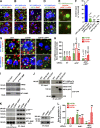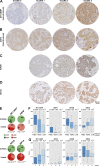ARF6-JIP3/4 regulate endosomal tubules for MT1-MMP exocytosis in cancer invasion
- PMID: 26504170
- PMCID: PMC4621834
- DOI: 10.1083/jcb.201506002
ARF6-JIP3/4 regulate endosomal tubules for MT1-MMP exocytosis in cancer invasion
Abstract
Invasion of cancer cells into collagen-rich extracellular matrix requires membrane-tethered membrane type 1-matrix metalloproteinase (MT1-MMP) as the key protease for collagen breakdown. Understanding how MT1-MMP is delivered to the surface of tumor cells is essential for cancer cell biology. In this study, we identify ARF6 together with c-Jun NH2-terminal kinase-interacting protein 3 and 4 (JIP3 and JIP4) effectors as critical regulators of this process. Silencing ARF6 or JIP3/JIP4 in breast tumor cells results in MT1-MMP endosome mispositioning and reduces MT1-MMP exocytosis and tumor cell invasion. JIPs are recruited by Wiskott-Aldrich syndrome protein and scar homologue (WASH) on MT1-MMP endosomes on which they recruit dynein-dynactin and kinesin-1. The interaction of plasma membrane ARF6 with endosomal JIPs coordinates dynactin-dynein and kinesin-1 activity in a tug-of-war mechanism, leading to MT1-MMP endosome tubulation and exocytosis. In addition, we find that ARF6, MT1-MMP, and kinesin-1 are up-regulated in high-grade triple-negative breast cancers. These data identify a critical ARF6-JIP-MT1-MMP-dynein-dynactin-kinesin-1 axis promoting an invasive phenotype of breast cancer cells.
© 2015 Marchesin et al.
Figures










Comment in
-
MT1-MMP: Endosomal delivery drives breast cancer metastasis.J Cell Biol. 2015 Oct 26;211(2):215-7. doi: 10.1083/jcb.201510009. J Cell Biol. 2015. PMID: 26504163 Free PMC article.
Similar articles
-
MT1-MMP: Endosomal delivery drives breast cancer metastasis.J Cell Biol. 2015 Oct 26;211(2):215-7. doi: 10.1083/jcb.201510009. J Cell Biol. 2015. PMID: 26504163 Free PMC article.
-
ARF6 Interacts with JIP4 to control a motor switch mechanism regulating endosome traffic in cytokinesis.Curr Biol. 2009 Feb 10;19(3):184-95. doi: 10.1016/j.cub.2008.12.043. Curr Biol. 2009. PMID: 19211056
-
Endosomal WASH and exocyst complexes control exocytosis of MT1-MMP at invadopodia.J Cell Biol. 2013 Dec 23;203(6):1063-79. doi: 10.1083/jcb.201306162. J Cell Biol. 2013. PMID: 24344185 Free PMC article.
-
Matrix invasion by tumour cells: a focus on MT1-MMP trafficking to invadopodia.J Cell Sci. 2009 Sep 1;122(Pt 17):3015-24. doi: 10.1242/jcs.034561. J Cell Sci. 2009. PMID: 19692588 Review.
-
Cellular and Molecular Mechanisms of MT1-MMP-Dependent Cancer Cell Invasion.Annu Rev Cell Dev Biol. 2016 Oct 6;32:555-576. doi: 10.1146/annurev-cellbio-111315-125227. Epub 2016 Aug 8. Annu Rev Cell Dev Biol. 2016. PMID: 27501444 Review.
Cited by
-
Integrated functions of membrane-type 1 matrix metalloproteinase in regulating cancer malignancy: Beyond a proteinase.Cancer Sci. 2017 Jun;108(6):1095-1100. doi: 10.1111/cas.13231. Epub 2017 May 22. Cancer Sci. 2017. PMID: 28267240 Free PMC article. Review.
-
A mechanism for exocyst-mediated tethering via Arf6 and PIP5K1C-driven phosphoinositide conversion.Curr Biol. 2022 Jul 11;32(13):2821-2833.e6. doi: 10.1016/j.cub.2022.04.089. Epub 2022 May 23. Curr Biol. 2022. PMID: 35609603 Free PMC article.
-
A role for kinesin-1 subunits KIF5B/KLC1 in regulating epithelial mesenchymal plasticity in breast tumorigenesis.EBioMedicine. 2019 Jul;45:92-107. doi: 10.1016/j.ebiom.2019.06.009. Epub 2019 Jun 14. EBioMedicine. 2019. PMID: 31204277 Free PMC article.
-
Protrudin-mediated ER-endosome contact sites promote MT1-MMP exocytosis and cell invasion.J Cell Biol. 2020 Aug 3;219(8):e202003063. doi: 10.1083/jcb.202003063. J Cell Biol. 2020. PMID: 32479595 Free PMC article.
-
Activating the nuclear piston mechanism of 3D migration in tumor cells.J Cell Biol. 2017 Jan 2;216(1):93-100. doi: 10.1083/jcb.201605097. Epub 2016 Dec 20. J Cell Biol. 2017. PMID: 27998990 Free PMC article.
References
-
- Artym V.V., Zhang Y., Seillier-Moiseiwitsch F., Yamada K.M., and Mueller S.C.. 2006. Dynamic interactions of cortactin and membrane type 1 matrix metalloproteinase at invadopodia: defining the stages of invadopodia formation and function. Cancer Res. 66:3034–3043. 10.1158/0008-5472.CAN-05-2177 - DOI - PubMed
-
- Castro-Castro A., Janke C., Montagnac G., Paul-Gilloteaux P., and Chavrier P.. 2012. ATAT1/MEC-17 acetyltransferase and HDAC6 deacetylase control a balance of acetylation of alpha-tubulin and cortactin and regulate MT1-MMP trafficking and breast tumor cell invasion. Eur. J. Cell Biol. 91:950–960. 10.1016/j.ejcb.2012.07.001 - DOI - PubMed
Publication types
MeSH terms
Substances
LinkOut - more resources
Full Text Sources
Other Literature Sources
Molecular Biology Databases
Research Materials
Miscellaneous

